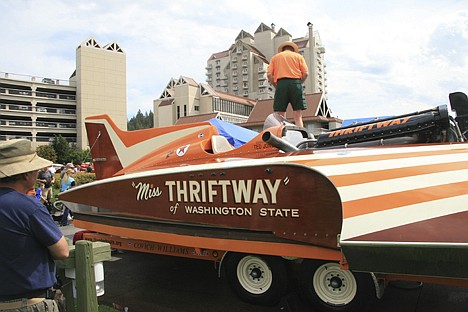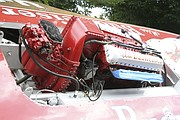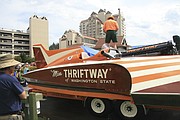Speed on display
David Cole | Hagadone News Network | UPDATED 15 years, 3 months AGO
COEUR d’ALENE — In more ways than one, hydroplanes have a lot in common with airplanes.
While they float like a boat, they don’t float much. While at speeds of sometimes up to 190 miles per hour on a straightaway, they literally fly over the surface of the water. Combine that flying with the airplane engines and aviation fuel.
Steve Payne, co-owner and crew chief of a replica of the 1955 Miss Thriftway, said the lift-off from about 80 mph to 140 or 150 mph is explosive.
“They are dangerous,” Payne said.
At one point, “all the friction goes away” between the boat and the surface of the water. At top speed, hardly any of the boat is actually touching the water, and it can feel unstable.
“You’re going over the top of the waves,” Payne said. “You slide through the turns.”
A driver at those speeds soon comes to an unsettling realization.
“I’m the softest thing here,” compared with the metal and wood of the boat and the unforgiving waves and water below, which tear a boat apart in a wreck, Payne said. “And if something bad happens, the softest thing is going to suffer.”
The heat and scream of the engine in a race is another thing.
Payne said half the guys who raced in the hydroplanes back in the days got killed, while of the other half, nearly all got hurt.
The replica 1955 Miss Thriftway was one of four hydroplanes on display Saturday at The Coeur d’Alene Resort and the Museum of North Idaho during the Diamond Cup Regatta, a celebration of the Diamond Cup unlimited hydroplane races on Lake Coeur d’Alene for 10 different summers from 1958 to 1968.
The Diamond Cup Regatta also included the 30-foot “Green Dragon” Miss Bardahl, with her 7,000 pounds and top speeds of more than 180 mph; the 30-foot 1968 Miss Budweiser, with her 7,400 pounds and top speeds of 190 mph; and a replica of the more than 28-foot 1956 Miss Wahoo, with her 6,000 pounds and top speeds of more than 160 mph.
Jon Osterberg, a member of the Miss Bardahl crew, said the original Miss Bardahl (the one on display Saturday is the third) competed for the first time ever in 1962 at the Diamond Cup, with Ron Musson driving.
“It struggled the first year,” he said. It improved quickly and was dominating races by 1965, when about 10 cities hosted races.
Osterberg said the 3-mile course on Lake Coeur d’Alene ran north and south, with the start just off the end of Tubbs Hill. Those watching the races crowded the hill and City Beach to hear the engines roar and see the long “rooster tails” shooting from the back.
“There would be just thousands of people on Tubbs,” he said.
According to the Museum of North Idaho, the Coeur d’Alene Unlimited Hydroplane Association brought the first hydroplane races to Coeur d’Alene. The racing ended here after 1968, because the Diamond Cup cost more money to put on than it generated in revenue.
There was no racing in 1967 because of the event’s deficits. Along with the debts, crowd problems and noise were also cited as reasons for the event’s demise, according to the museum.
ARTICLES BY DAVID COLE
Firefighters battle Athol fires
ATHOL — Dry and breezy conditions Friday and a homeowner torching weeds accidentally set in motion a fast-moving wildland fire that burned roughly 50 acres.
Wandering grizzly gets to Glacier
COEUR D’ALENE, Idaho — Ethyl, the 20-year-old wandering female grizzly, has arrived at one of the greatest grizzly bear territories in the world — Glacier National Park.
Update: Samuel verdict in
Closing arguments completed Friday morning







